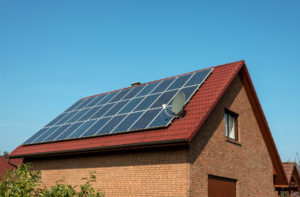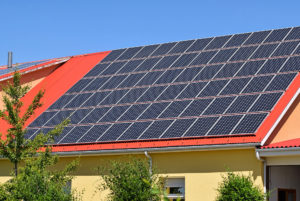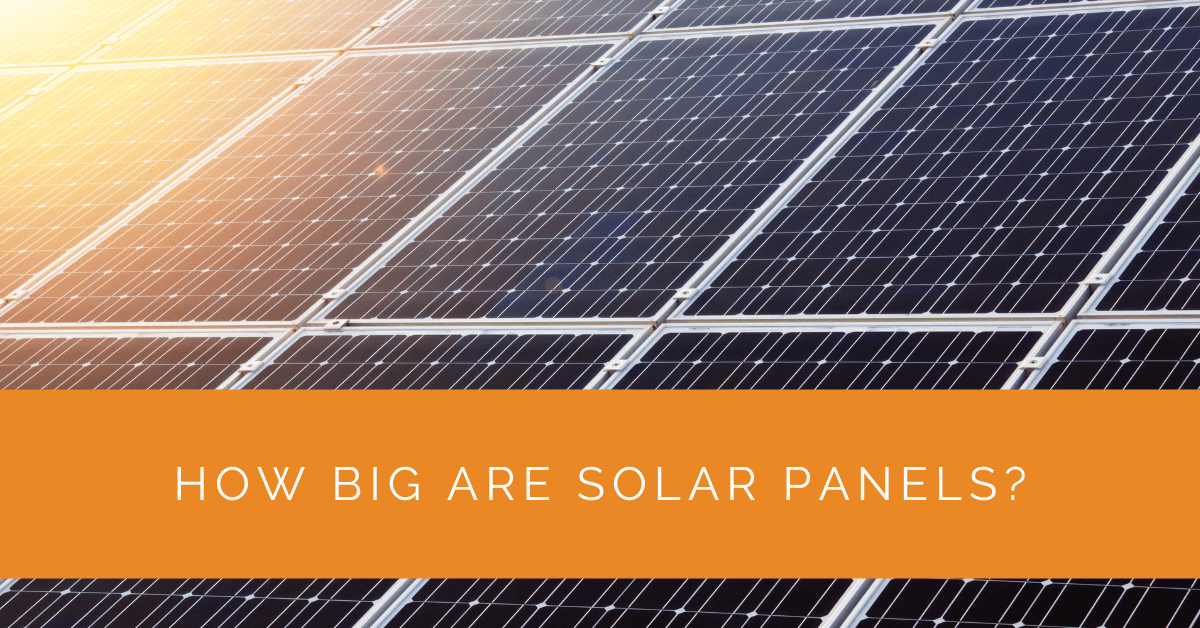Solar panels are a critical component of any solar power system, whether it’s for residential or commercial use. Understanding the size of solar panels is essential for planning a solar installation that meets your energy needs and fits your available space. In this comprehensive guide, we’ll explore the dimensions and weight of solar panels, factors that affect their size, and how to choose the right-sized solar panels for your specific requirements.
Contents
- 1 Key Takeaways
- 2 Standard Solar Panel Sizes
- 3 Determining the Right Size of Solar Panels
- 4 Solar Panel Space Calculator
- 5 Best Solar Panels by Size
- 6 Solar Panel Weight
- 7 Case Study: Residential Solar Installation
- 8 Expert Insights From Our Solar Panel Installers About Solar Panel Sizes
- 9 Experience Solar Excellence with Us!
- 10 Conclusion
Key Takeaways
- Solar panel sizes vary depending on efficiency, type, and power output, with residential panels typically measuring around 65 inches by 39 inches.
- The right-sized panels are determined by energy needs, available space, and panel efficiency, and professional guidance is essential for accurate sizing.
- While solar panels are relatively lightweight, their weight should be considered for safe installation, especially on roofs, and professional installers ensure structural integrity and safety.
Standard Solar Panel Sizes
Dimensions of Typical Residential Panels
Residential solar panels come in various sizes, but standard dimensions are commonly used. The most typical residential solar panel measures approximately 65 inches in height and 39 inches in width. This size is often called the “60-cell” or “72-cell” panel, based on its number of solar cells.
These dimensions are carefully chosen to balance power output and practicality. The 60-cell panel, for instance, provides a good balance of size and efficiency for most residential installations. It’s essential to note that while this size is standard, solar panels can come in different dimensions depending on the manufacturer and the specific design of the panel.
Dimensions of Commercial and Utility-Scale Panels
Commercial and utility-scale solar panels tend to be larger to accommodate higher power generation needs. These panels can vary significantly in size, with dimensions exceeding 77 inches in height and 40 inches in width.
The size of commercial and utility-scale panels results from their advanced technology and the need to generate more power within limited space. These larger panels are often used in solar farms and large-scale installations, where maximizing power output is crucial.
Factors That Affect Solar Panel Size
The size of a solar panel is influenced by several factors, including:
- Solar Cell Efficiency: Higher-efficiency panels often require less space to generate the same power.
- Type of Solar Panel: Monocrystalline and polycrystalline panels have different cell arrangements and efficiencies, impacting their size.
- Power Output: Panels that produce more watts will generally be larger to accommodate additional solar cells.
The choice of solar panel size depends on various considerations, including the available installation space, energy generation goals, and budget constraints. Residential installations often opt for standard-sized panels, while commercial projects may use larger, more efficient panels to maximize energy production within limited roof or ground space.

Determining the Right Size of Solar Panels
Factors That Determine Solar Panel Size
Several critical factors influence the selection of solar panel size for your solar power system:
- Energy Needs and Consumption: Your energy consumption and the amount of power you wish to generate will dictate the number and size of panels required.
- Available Roof or Ground Space: The physical space available for solar installation, whether on your roof or ground, is a key factor.
- Solar Panel Efficiency: Higher efficiency panels can generate more power per square foot.
- Type of Solar Panel: Different solar panels have varying efficiencies and sizes.
It’s important to consider these factors carefully when sizing your solar panels. Residential installations, for example, must balance available roof space with energy needs to ensure optimal performance.
Calculating the Number of Solar Panels You Need
You can use the manufacturers’ solar panel size chart to determine the number of solar panels required for your system. These charts outline the power output and dimensions of various panel models. Considering your energy consumption and the available space, you can calculate the total wattage needed and select the appropriate number of panels.
Calculating the number of panels is crucial in designing your solar power system. It ensures you generate sufficient electricity to meet your needs while maximizing available space.
Solar Panel Space Calculator
Find out how many solar panels can fit on your roof.
This is an estimate based on flat roof space. Actual installation depends on tilt, shading, and spacing requirements.
Sizing Solar Panels for Your Solar Power System
Professional solar installers can help you size your solar panels accurately. They consider shading, orientation, tilt, and regional climate conditions to optimize your system’s performance and size. Additionally, they can recommend the best type of solar panel for your specific requirements.
Choosing the right-sized panels is essential for achieving your energy goals and maximizing your solar investment. While standard-sized panels are commonly used for residential installations, expert guidance can help you tailor your system to your unique needs and available space.

Best Solar Panels by Size
Comparing Different Types of Panels
When choosing solar panels, you’ll encounter various types, including monocrystalline and polycrystalline panels and thin-film solar panels. Each type has unique characteristics, including efficiency and size.
- Monocrystalline Panels: These panels are known for their high efficiency and sleek appearance. They typically have a smaller footprint and are an excellent choice for installations with limited space.
- Polycrystalline Panels: Polycrystalline panels are also efficient and cost-effective. While they may have slightly larger dimensions than monocrystalline panels, their affordability makes them popular for residential installations.
- Thin-Film Solar Panels: Thin-film panels are flexible and lightweight, making them suitable for unique applications and non-standard surfaces. They have varying sizes and efficiencies depending on the specific technology used.
Choosing the Right-Sized Solar Panels for Your Needs
Balancing efficiency and available space is crucial when selecting solar panels. Residential solar installations typically use standard-sized panels that offer a good balance between efficiency and affordability. Commercial installations may opt for larger, more efficient panels to maximize power generation within limited space constraints.
When choosing the right-sized panels, it’s essential to consider your specific goals and budget. Solar installers can provide recommendations based on your energy needs and available space, helping you make an informed decision.
Solar Panel Weight
How Much Do Solar Panels Weigh?
Solar panels are relatively lightweight compared to their size. Residential panels typically weigh between 40 to 50 pounds (18 to 23 kilograms). Commercial panels can be heavier due to their larger size, weighing up to 60 pounds (27 kilograms) or more. Considering panel weight when planning your solar installation is important to ensure proper support and structural integrity.
The weight of solar panels is generally manageable for most residential and commercial structures. However, assessing the load-bearing capacity of your roof or mounting structure is crucial to ensure it can safely support the panels and associated equipment.
Implications for Roof or Ground Installation
The weight of solar panels is a critical consideration for roof-mounted installations. Roof structures must support the added weight of the panels, racking, and associated equipment. Ground-mounted installations offer more flexibility in this regard, as they can be designed to accommodate the weight of the panels without affecting existing structures.
Solar installers perform structural assessments to ensure that the installation site can safely support the weight of the panels. They may recommend reinforcement or adjustments if necessary.
Safety Considerations When Handling Solar Panels
Handling solar panels requires proper safety measures. While not excessively heavy, caution should be exercised during installation to prevent accidents or damage to the panels. Professional solar installers are trained to handle panels safely and follow industry best practices to ensure secure installations.
Case Study: Residential Solar Installation
Background
At Solar Panels Network USA, we recently had the pleasure of working with a family in Maine who wanted to install a solar power system on their home. Their primary goals were to reduce their energy bills and contribute to environmental sustainability by utilizing solar energy. Given their enthusiasm for renewable energy, we aimed to maximize their energy production while ensuring the solar panels fit seamlessly on their roof.
Project Overview
The project involved installing a 6 kW solar panel system on their residential roof. Considering Maine’s varied weather conditions, we designed a robust and efficient system that could perform well throughout the year.
Implementation
Site Assessment and Planning: Our initial assessment involved measuring the roof space and evaluating its orientation and tilt. We found that the family’s roof had a south-facing section that received ample sunlight, making it ideal for solar panel installation. We also evaluated the structural integrity of the roof to ensure it could support the weight of the solar panels.
Choosing the Right Panels: Based on the roof dimensions and the family’s energy needs, we selected high-efficiency monocrystalline panels. These panels offered a good balance between size and power output, allowing for maximum energy production within the available roof space. Each panel measured approximately 65 inches by 39 inches and weighed around 42 pounds.
Installation: The installation process began with mounting the racking system to the roof. This system provided the foundation for the solar panels and ensured they were securely attached. We then installed the panels in rows, aligned to optimize sunlight exposure. Electrical wiring was connected to an inverter, which converted the generated DC power into usable AC power for the home.
Integration with the Grid: We connected the system to the local power grid to allow for net metering. This arrangement enabled the family to sell excess power back to the utility company, further reducing their electricity costs.
Results
After installation, the solar panel system produced an average of 7,500 kilowatt-hours (kWh) annually, covering a significant portion of the family’s energy needs. The high-efficiency panels performed well, even during Maine’s colder months, due to their superior low-light performance and the natural cooling effect provided by the cold climate, which enhanced their efficiency.
The family saw a substantial reduction in their electricity bills, saving hundreds of dollars annually. Additionally, the net metering arrangement allowed them to earn credits for surplus energy produced, providing further financial benefits.
Summary
This residential solar installation in Maine demonstrates the importance of selecting the right-sized solar panels and ensuring proper installation. By choosing high-efficiency panels and conducting a thorough site assessment, we were able to maximize energy production and achieve significant cost savings for the family. This case study highlights the effectiveness of our solar energy solutions in residential settings and underscores the benefits of professional installation and careful planning.
Expert Insights From Our Solar Panel Installers About Solar Panel Sizes
Choosing the right size of solar panels for your home is crucial for maximizing efficiency and ensuring that your system meets your energy needs. The dimensions of the panels need to fit your roof space while providing sufficient power output.
The weight and size of solar panels must be carefully considered during installation. Proper structural assessment is essential to ensure that the roof can support the additional load without compromising safety.
Higher efficiency panels, though sometimes slightly larger, can produce more power per square foot. This makes them an excellent choice for homes with limited roof space, as they allow for more energy production with fewer panels.
Experience Solar Excellence with Us!
Trust in Solar Panels Network USA, where our seasoned experts deliver top-quality solar solutions for homes and businesses nationwide. With a legacy of countless successful installations and a commitment to sustainable energy, we’re your reliable partner in the solar journey. Ready for a brighter, eco-friendly future? Call us now at (855) 427-0058 and harness the power of the sun!
Conclusion
Understanding the size of solar panels is essential for planning a solar power system that meets your energy needs and fits your available space. Whether considering residential or commercial solar installation, selecting the right-sized panels is critical. By considering factors such as energy consumption, available space, panel efficiency, and type of solar panel, you can make informed choices that optimize power generation and contribute to a more sustainable future.
If you have questions about solar panel dimensions or need assistance with sizing your solar panels, don’t hesitate to consult professional solar installers who can provide expert guidance tailored to your specific requirements. Making the right choices regarding solar panel size and weight ensures your solar power system’s successful and efficient operation.
About the Author
Solar Panels Network USA stands at the forefront of solar energy solutions, driven by a team of seasoned solar engineers and energy consultants. With over decades of experience in delivering high-quality solar installations and maintenance, we are committed to promoting sustainable energy through customer-centric, tailored solutions. Our articles reflect this commitment, crafted collaboratively by experts to provide accurate, up-to-date insights into solar technology, ensuring our readers are well-informed and empowered in their solar energy decisions.

